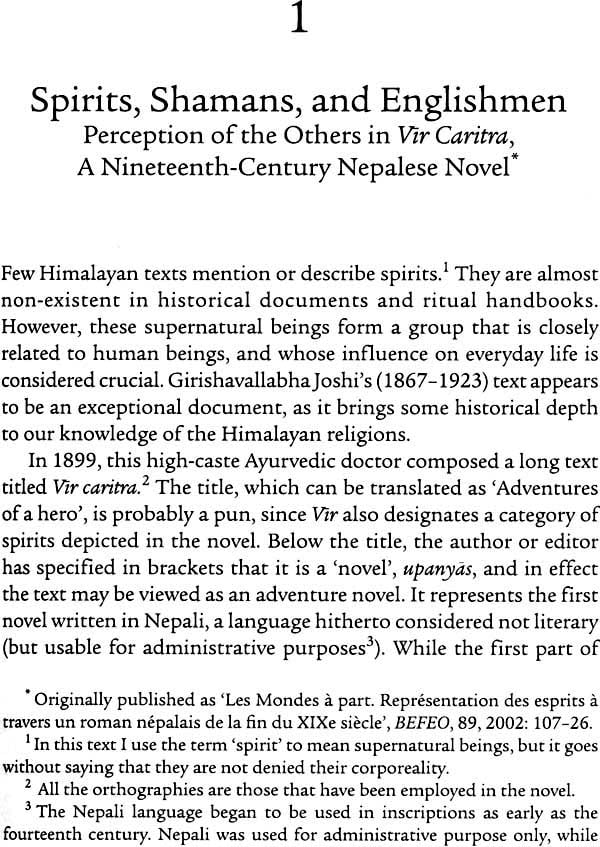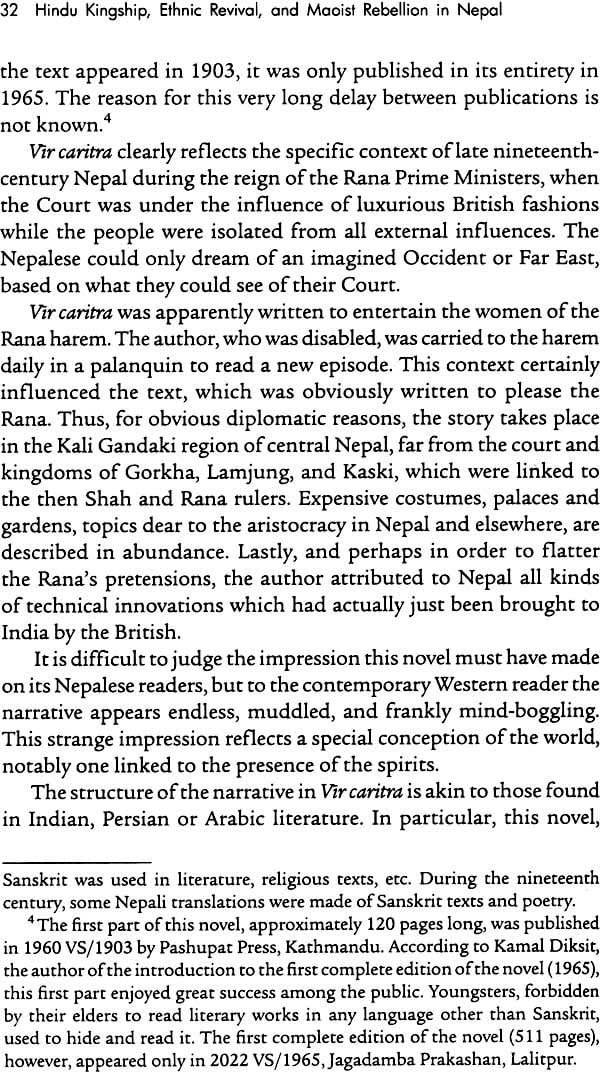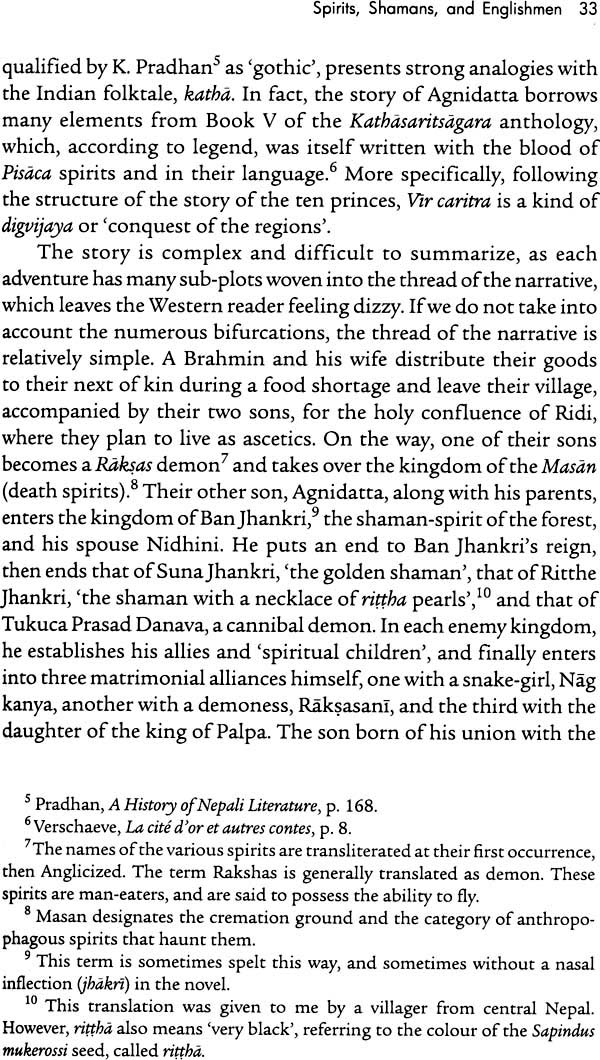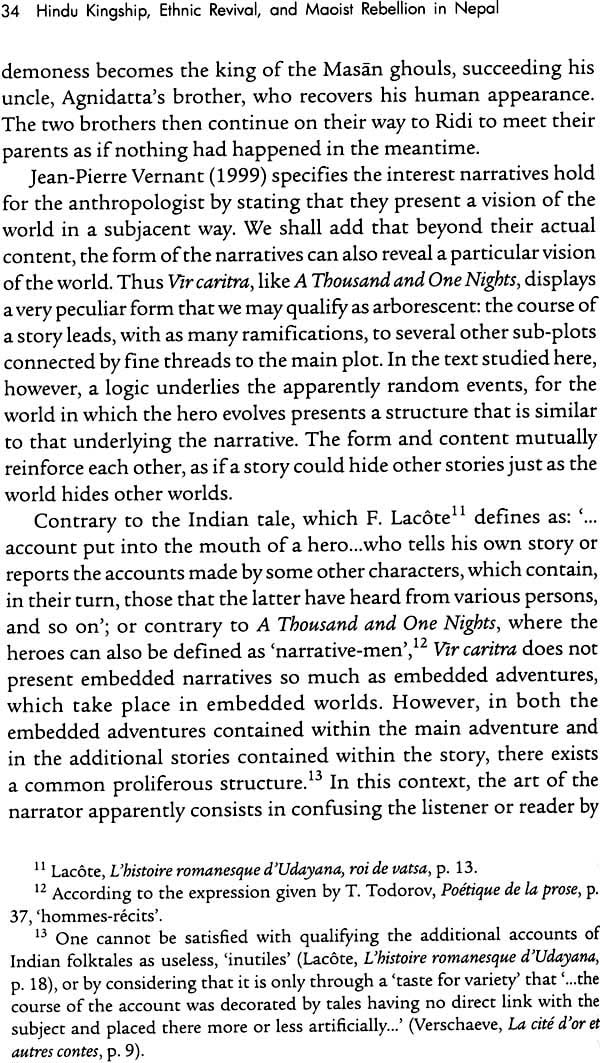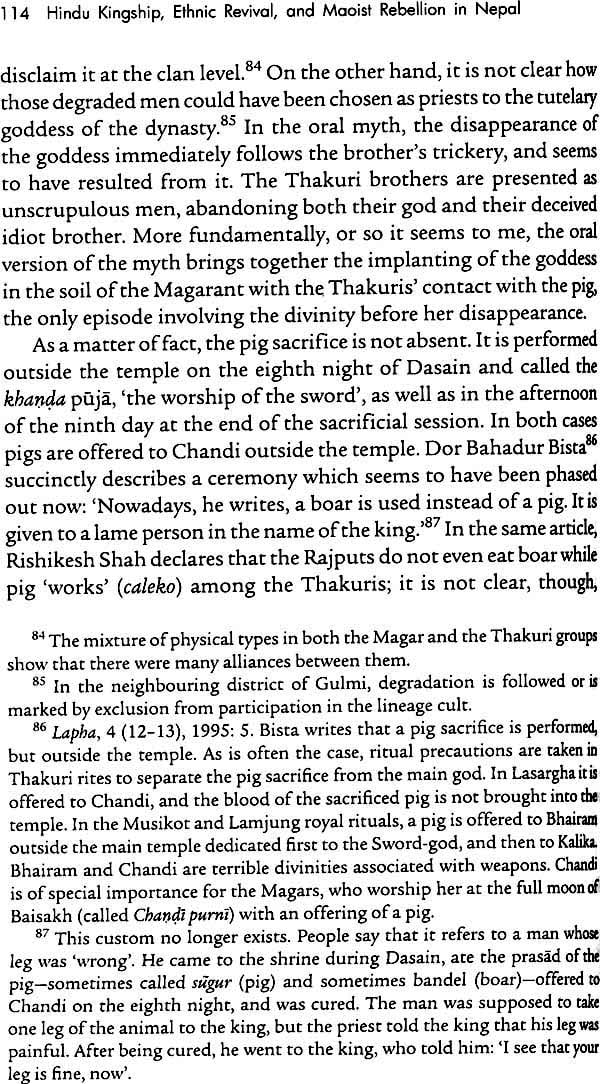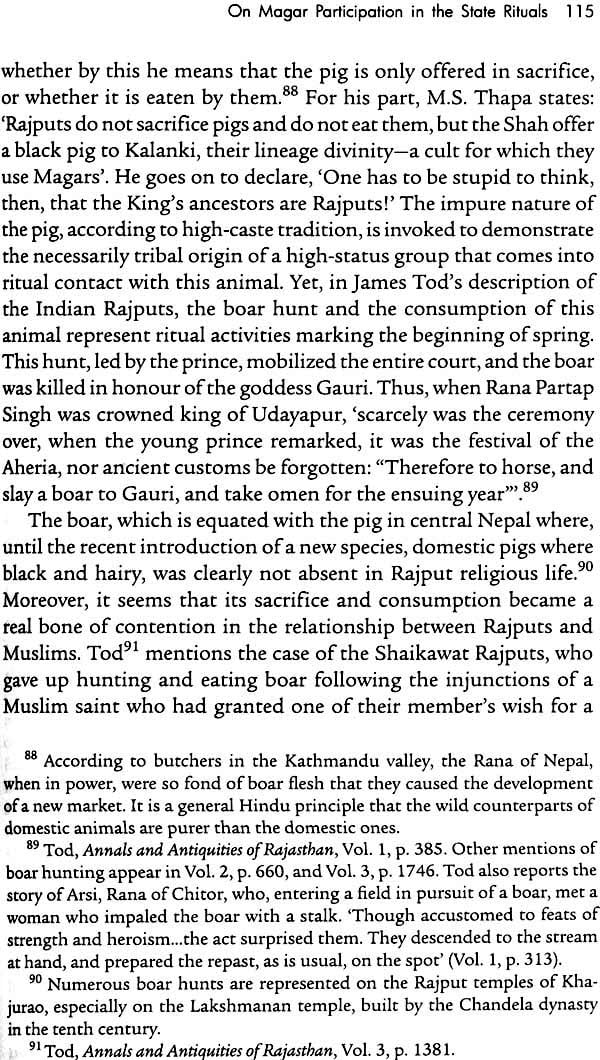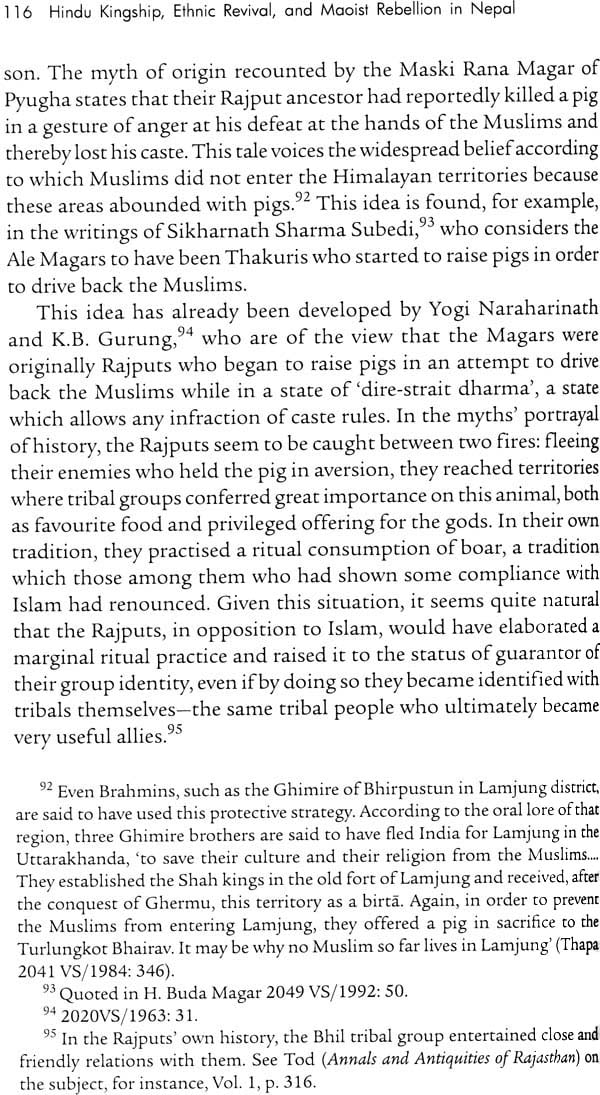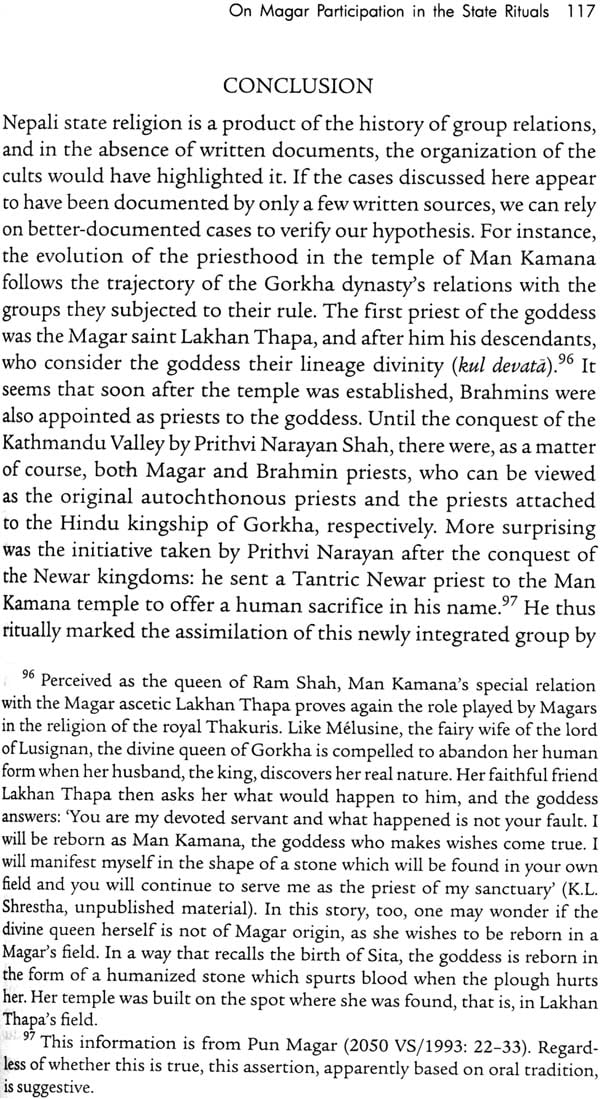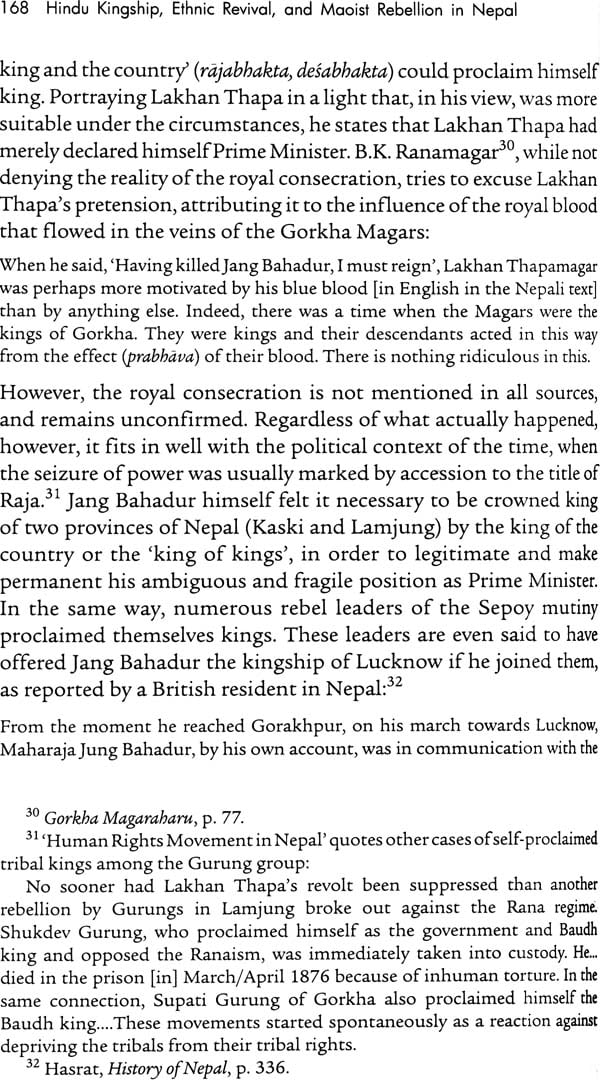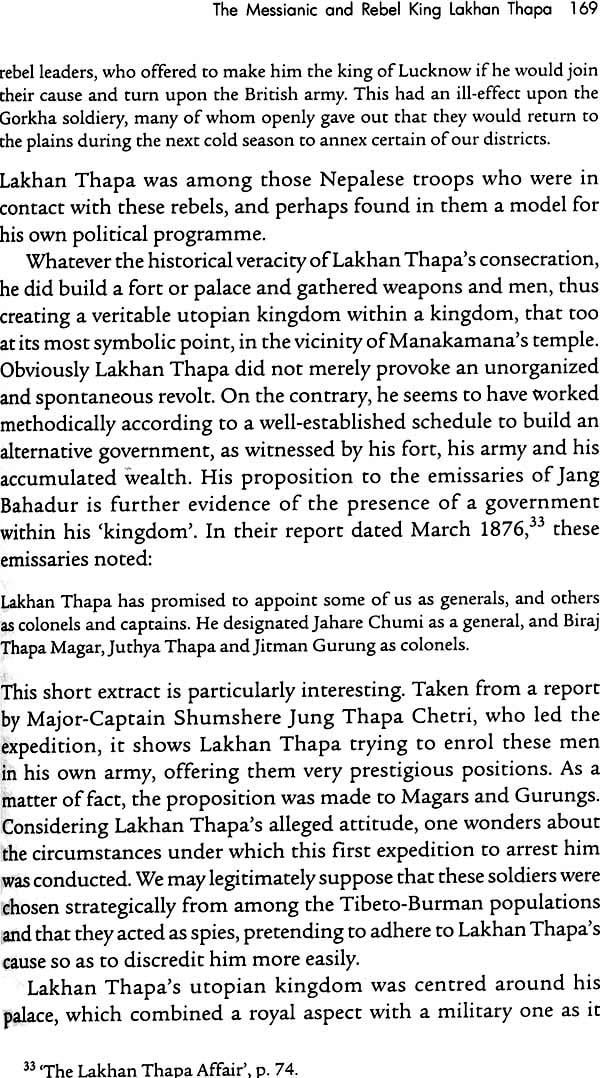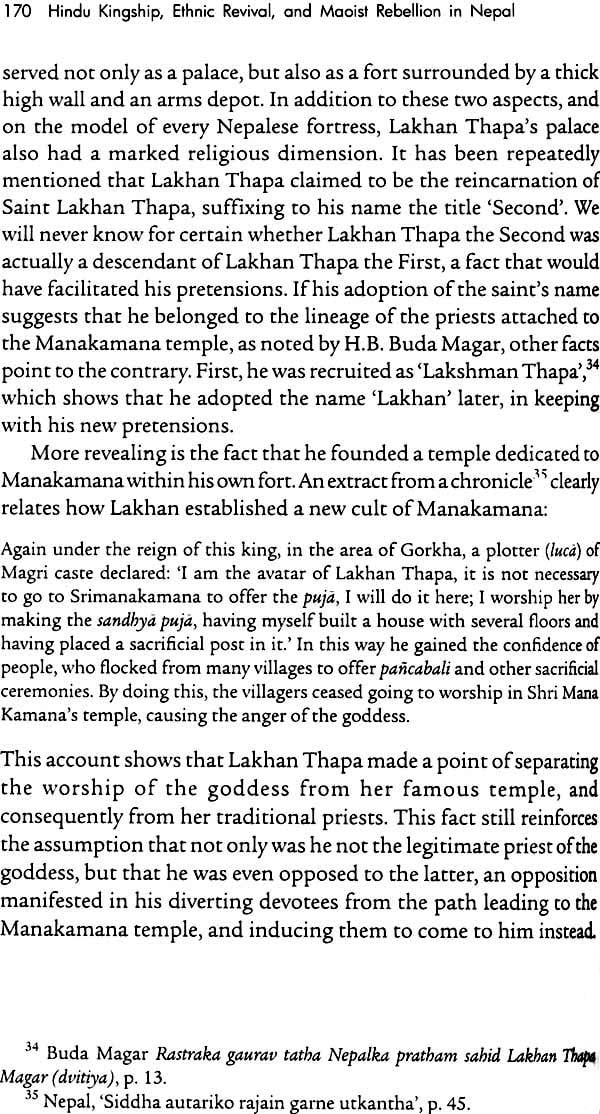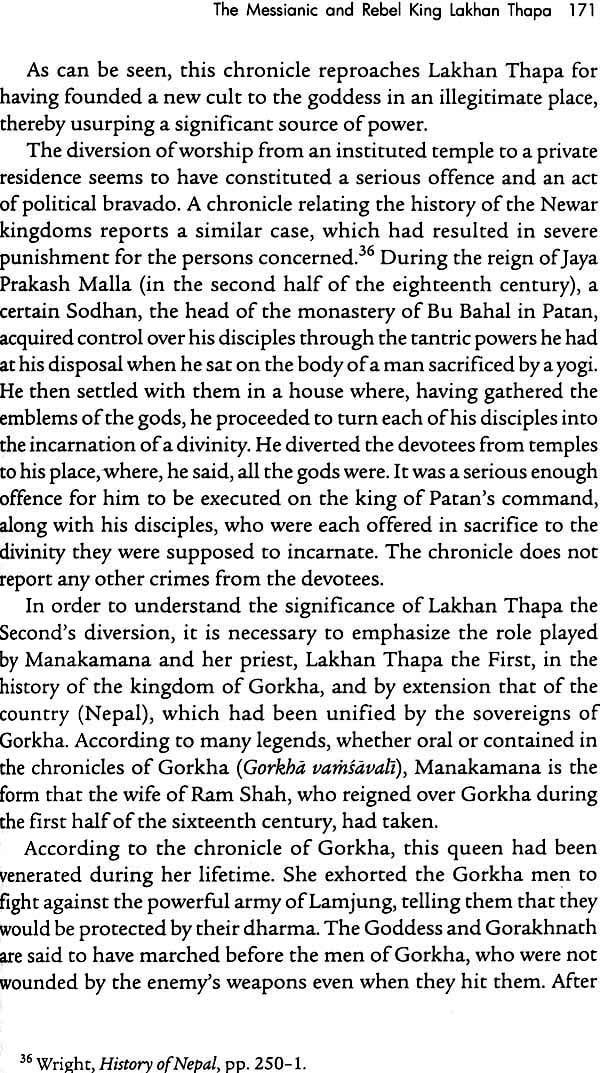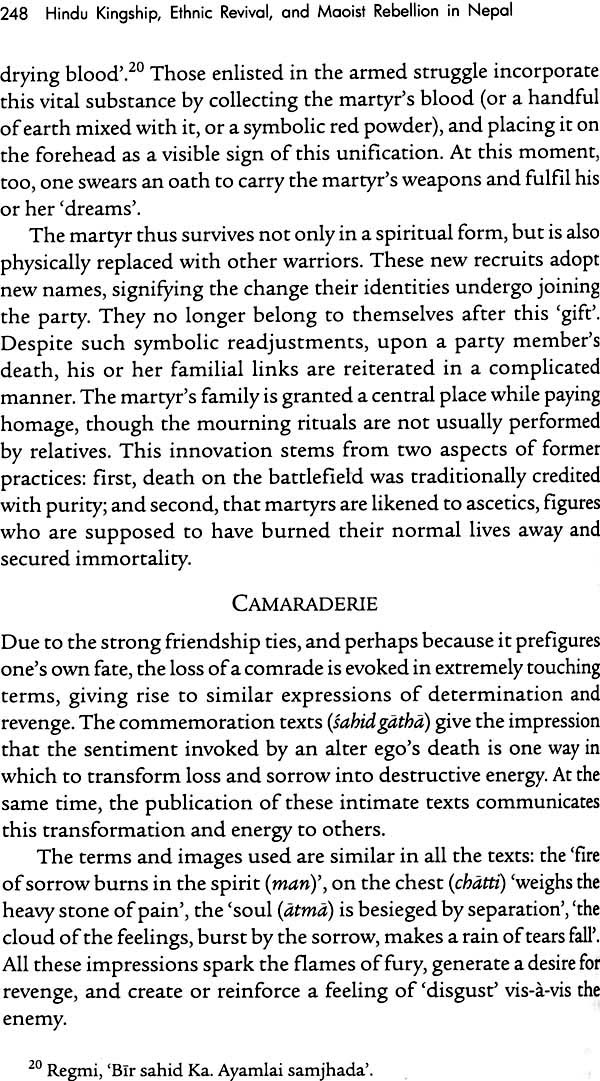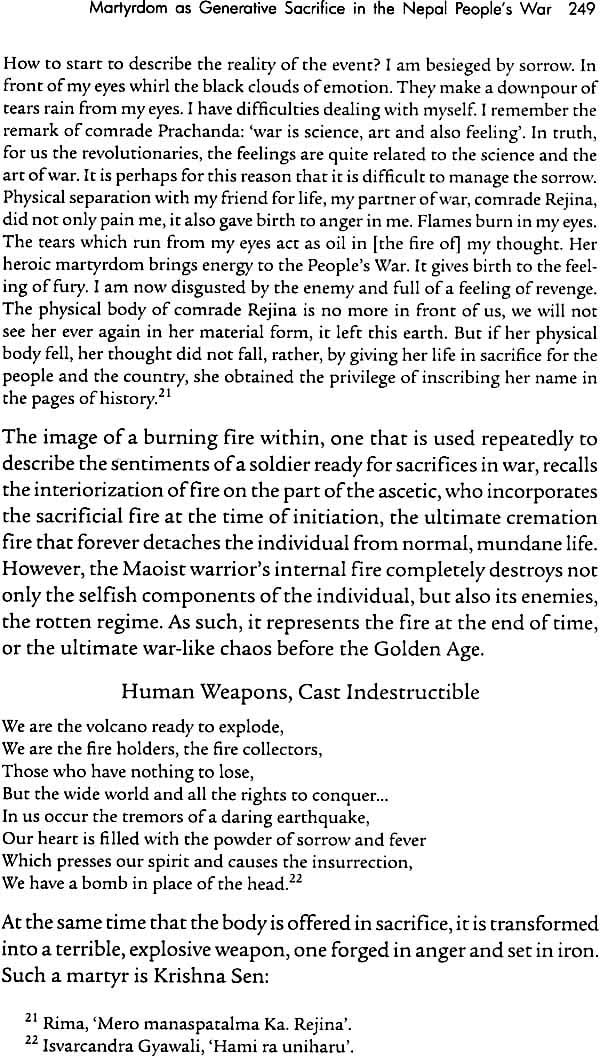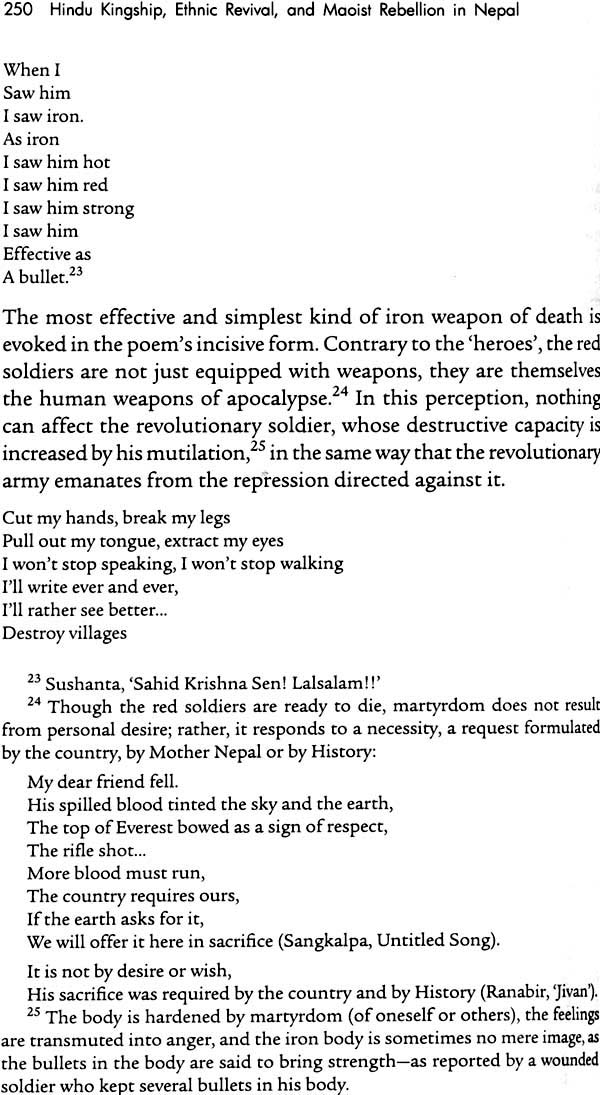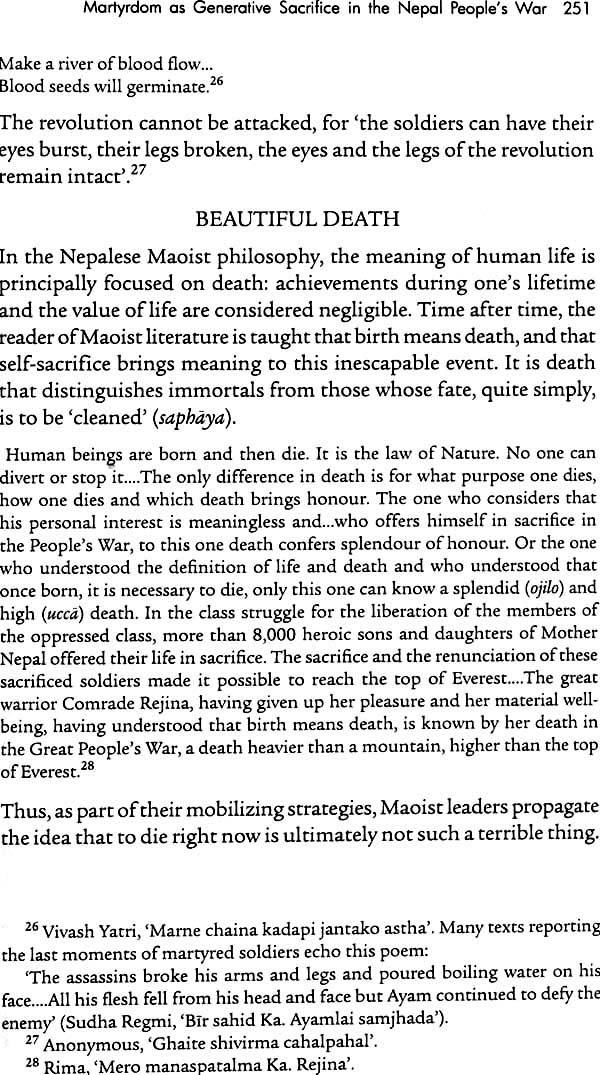
Hindu Kingship, Ethnic Revival, and Maoist Rebellion in Nepal
Book Specification
| Item Code: | NAL611 |
| Author: | Marie Lecomte-Tilouine |
| Publisher: | Oxford University Press, New Delhi |
| Language: | English |
| Edition: | 2013 |
| ISBN: | 9780198072256 |
| Pages: | 308 |
| Cover: | Paperback |
| Other Details | 8.5 inch x 5.5 inch |
| Weight | 350 gm |
Book Description
This book explores the linkages between Nepalese identity, ethnicity, and the Maoist rebellion. It traces the emergence of dualist conceptions of society which took root in tribal revivalism and ultimately nourished the Maoist rebellion in Nepal. The author analyses this interplay using diverse sources, including fiction and poetry; myths and rituals; inscriptions; historical hronicles and contemporary accounts; and academic and polemical publications. She further explores the critical theme of 'otherness', and provides insights into the way domination functions.
This volume will interest students and scholars of sociology, anthropology, and history as well as those working on contemporary Nepal.
Marie Lecomte-Tilouine is senior researcher in social anthropology at Cnrs, France. She specializes in the study of the Himalayan region.
For a long time, Nepal was presented as a model of harmony and tolerance. Its highly composite population maintained apparently peaceful relations, and therefore few studies focused on group interaction. With the 1990s, two successive, yet interrelated, contestatory movements emerged: ethnic revivalism, which transformed the society while itself, emerging from that transformation; and the Maoist rebellion, which attracted worldwide attention both for its bloody aftermath and its anachronism. I lived for some months in central Nepal before the emergence of these movements, studying a multi-caste and multi-ethnic village community, where group interaction determined identity, behaviour, and village politics. In such a context, isolating one specific group from its neighbours was simply impossible. This first experience of fieldwork formed my own conception of Nepalese culture, gave shape to the Nepali language I spoke, and decided my future interests. This collection of essays reflects the approach I then adopted-that of basing my analysis of identity and interactions on both written sources and oral conversations, a combination that makes it possible to consider the diachronic dimension of the various groups' relationships. The volume follows two main threads, those of tribal identity and Maoist rebellion, confronted with Hindu kingship and caste organization.
Nowhere more than in the hills of central Nepal has the Hindu caste organization come in close contact with the tribal world. It is believed that Hindu kingdoms were established there only in the fifteenth entury because of the alliances that Hindu rulers contracted with the local population, especially tribal chiefs. The indigenous people, or janajatis, still form a third of the country's total population. Among them, the Magars, the main autochthonous population of central Nepal and the focus of this volume, represent the largest janajati group of resent-day Nepal, with over one and a half million individuals. They form the Nepalese janajati group which in the past had developed the closest relationship with Hinduism, Hindu kingship and caste organization, and which countered it most radically ecently. In this volume we shall explore the strategies adopted by the Magars in the course of their relations with their high-caste neighbours, from sanskritization and ritual integration to contestation, de-sanskritization, and revolution (Chapters 2-5). These strategies are of course not unilateral, and should be understood within the scope of action allowed to this group by Hindu ideology, and instrumentalization of the latter within the state organization (Chapters 3 and 6). For this reason, they can only be comprehended in their historical context. However, the lack of information on most of the regions which, two centuries ago, had become the kingdom of Nepal, led us to use all the means available to us. Various data thus bring grist to our mill: fiction (novels and poetry), inscriptions, chronicles, myths and rituals, social behaviour, and contemporary accounts, as well as academic or polemical publications.
Our investigation begins and ends with fiction, leading the reader into two quite distinct symbolic universes: first, on a journey with a young Brahmin into the world of spirits, tribal shamans, and English gentlemen (Chapter 1), and finally on another journey, this time in the company of soldiers offering themselves in sacrifice on the bloody path of the Maoist revolution (Chapter 8). Through these two journeys, made one century apart, we will explore the relations with Otherness, be it the result of old classifications as in the first case, or of a new ongoing construction, as in the second. They serve as a framework for underlining some features of Nepalese society and its evolution. The first fiction, a shamanic journey, depicts a travel into alterity, into various worlds existing apart, yet co-existing and interacting with the human, Hindu space. In many respects, the Hindu-tribal relation depicted in this work appears not only as a conquest, but also as a special way of treating others, which relies on one's ability to view oneself from someone else's perspective, a way that we call alterocentrism. In this book I try to show how alterocentrism has evolved into its complementary face, that is, alterization, parallel to an increasingly negative evaluation of several Hindu fundamental principles. Whereas alterocentrism seems to be a corollary of the social complexity and holistic nature of caste society, alterization emerges with dualist conceptions of society and political opposition. We will return to these two notions later. The last journey into Nepalese fiction is an illustration of how this evolution, whose roots can apparently be traced to tribal revivalism, in turn nourished the Maoist revolution and contributed to the formation of its universe, which is characterized by bilateralism and asymmetry. The Maoist ideology in Nepal thus converges with the tribal movement in the sense that both have led, via different paths, to a conception of society that is composed of two moieties, the oppressors and the oppressed for the first, the Aryans and the Mongols for the second. Both models were constructed in opposition to the caste organization and Hindu monarchy, and in many respects overlap each other. We have chosen a narrative and fictional framework for this study, considering, like Michel Foucault, that discourse is not only what translates struggles or systems of domination, but also what one struggles for, and the means by which one struggles, Focusing on the case of Pierre Riviere' who killed 'his father, mother, brother and sister', Foucault highlighted the real 'battle' of discourses, which took place between doctors, representatives of the law, villagers, and the murderer himself. That surrounds the fate of an individual.
The social dialogue in Nepal recalls this multi-sided narrative dynamism. It evokes a permanent construction game in which the same elements are placed in different orders by different players to make up an edifice that is more or less fragile." In such a context, social anthropology cannot remain the study of a single group, region, or time. Against the backdrop of the diversity characterizing the geographical environment, status, language and religion of Nepalese society, and the communal and political trends of these last decades, identity has been constructed through a relational game between groups in perpetual motion, where each is defined with respect to the Other. However, this chronic instability does not mean an absence of functioning rules. These, we would argue, shape the way the other is treated, and are followed by everyone. Their study thus represents, rather than that of the changing social regroupings they regulate, an effective way in which to understand Nepalese and, more generally, Hindu society.
Nepalese society has long been structured by the caste system, that is, a social organization founded on internal alterity. Though this type of social organization was clearly imposed on a large section of the population, notably the indigenous peoples, over the course of a few centuries identity and alterity, as we show later, present reflective (or retro projective) features rather than projective ones.
When dealing with identity and alterity, the anthropologist cannot dissociate him/herself from the study, for s/he is also representative of Otherness in the society studied. The problem is how to take oneself into account, or how to carry out an embryonic auto-epistemology, without being ensnared into a purely subjective narrative.
A position now common in anthropology takes the view that since objectivity is a utopian goal, it is preferable to adopt a clearly committed attitude and delight in subjectivity. In Nepal, for instance, this trend is advocated in the field of history by Pratyoush Onta, who 'suggests that historians abandon the disciplinary virtues as "objectivity" along with the state-centric view of Nepali history, and 'produce passionate poly-centric histories. A multiplicity of subjective accounts would thus allow one to solve the problem of the free exercise of research and of the links between 'objectivity' and the 'official viewpoint. However, to borrow Plato's allegory, this would amount to painting with a single colour the shadows which are all that men chained in a cave can perceive of the outside world, arguing that a reproduction of their exact colours is impossible. The multiplicity of such paintings in monochrome would not provide a better understanding of the world, but would at least have the advantage of troubling the men in the cave, who would realize that there are as many realities as there are painters. I should add that the chained men would not get a more accurate understanding of the outside world were the artists to begin by explaining their choices of using a particular colour, following the precept of the subjectivists who often suggest that the 'subject' (that is the scholar) defines his own position at the outset.
| List of Photographs and Map | ix | |
| Acknowledgements | xi | |
| Publisher's Acknowledgements | xiii | |
| Introduction: Stereotypes, Alterocentrism, and Alterization in Nepal | 3 | |
| 1 | Spirits, Shamans, and Englishmen: Preception of the Other in Vir Caritra, a Nineteenth-century Nepalese Novel | 31 |
| 2 | Hindu Power in a Tribal Territory: The Cult of Bhume among the Marge | 61 |
| 3 | The Enigmatic Pig: On Magar Particioation in the State Rituals of Nepal | 81 |
| 4 | Desansktitization of the Magars: Ethno- History of a Group with No History | 122 |
| 5 | The Messianic and Rebel King Lakhan Thapa: Utopia and Ideology among the Magars | 156 |
| 6 | The Transgressive Nature of Hindu Kingship in Nepal | 193 |
| 7 | Regicide and Maoist Revolutionary Warfare in Nepal: Modern Incarnations of a Warrior Kingdom | 220 |
| 8 | Kill one, he becomes one hundred': Martydom as Generative Sacrifice in the Nepal People's War | 238 |
| Postscript | 267 | |
| Bibliography | 270 | |
| index | 284 | |
